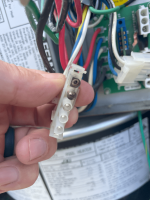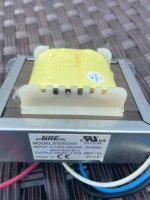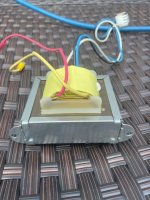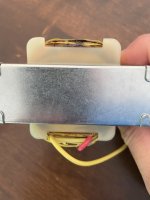Jandy JXI (200N) heater short blowing PDB
- Thread starter kyleshea
- Start date
You are using an out of date browser. It may not display this or other websites correctly.
You should upgrade or use an alternative browser.
You should upgrade or use an alternative browser.
Hello all!
I'm suddenly having a problem with my Jandy JXI200N natural gas heater which is about 4 years old. I noticed the pool pump was off when scheduled on, and ultimately found a tripped circuit breaker. Flipping the breaker restored the pump but the heater remained OFF (yes, the pool installers wired the heater and pump to the same circuit.). Inside the heater I found an obviously blown power distro board (PDB, see pics). I swapped this part out, checked for any obvious shorts and found nothing. However IMMEDIATELY upon restoring power to the heater (no delay what so ever), it blew another PDB very similarly to the original in markings and damage. Again I can't find any obvious shorts and I'm trying to determine if perhaps the short is in the blower motor or if the cause is the transformer which I hear can be problematic. I'd love to find out before I wire up another PDB (and transformer while I'm at it) and blow those up if the problem lies elsewhere I've heard of making a jumper / extension cord to test the blower with outside power but I'd need somebody to explain how to wire this up.
I've heard of making a jumper / extension cord to test the blower with outside power but I'd need somebody to explain how to wire this up.
I'd certainly appreciate anybody who's familiar with this to please weigh in and let me know what the most likely suspect is here! Let me know if you can determine anything from the pics!
I'm suddenly having a problem with my Jandy JXI200N natural gas heater which is about 4 years old. I noticed the pool pump was off when scheduled on, and ultimately found a tripped circuit breaker. Flipping the breaker restored the pump but the heater remained OFF (yes, the pool installers wired the heater and pump to the same circuit.). Inside the heater I found an obviously blown power distro board (PDB, see pics). I swapped this part out, checked for any obvious shorts and found nothing. However IMMEDIATELY upon restoring power to the heater (no delay what so ever), it blew another PDB very similarly to the original in markings and damage. Again I can't find any obvious shorts and I'm trying to determine if perhaps the short is in the blower motor or if the cause is the transformer which I hear can be problematic. I'd love to find out before I wire up another PDB (and transformer while I'm at it) and blow those up if the problem lies elsewhere
I'd certainly appreciate anybody who's familiar with this to please weigh in and let me know what the most likely suspect is here! Let me know if you can determine anything from the pics!
Attachments
According to the pictures, its not burning the transformer side of the board, nor does the transformer itself look damaged, they turn brown (burned) when they short.
That leaves the fan/blower circuit. You can get a new board, install and leave the 5-pin plug out. Power on the heater. If it doesn't blow, insert the transformer plug. If it doesn't blow, its the fan circuit or fan itself.
Be sure the voltage selection board is for the proper input voltage.
Or, hire a pro that's familiar with a Jandy heater. Might be less expensive in the long run.
That leaves the fan/blower circuit. You can get a new board, install and leave the 5-pin plug out. Power on the heater. If it doesn't blow, insert the transformer plug. If it doesn't blow, its the fan circuit or fan itself.
Be sure the voltage selection board is for the proper input voltage.
Or, hire a pro that's familiar with a Jandy heater. Might be less expensive in the long run.
Thanks poolman. I follow and will do... I truly like to try and learn while being safe and thorough - BUT if I strike out I have nothing against calling a pro. It certainly may come to that. I fear this could be the blower, I checked resistance with a multimeter and got unexpected readings of 0 and open while connected with one probe on white and the other to the rest.According to the pictures, its not burning the transformer side of the board, nor does the transformer itself look damaged, they turn brown (burned) when they short.
That leaves the fan/blower circuit. You can get a new board, install and leave the 5-pin plug out. Power on the heater. If it doesn't blow, insert the transformer plug. If it doesn't blow, its the fan circuit or fan itself.
Be sure the voltage selection board is for the proper input voltage.
Or, hire a pro that's familiar with a Jandy heater. Might be less expensive in the long run.
- Oct 25, 2015
- 5,432
- Pool Size
- 28000
- Surface
- Plaster
- Chlorine
- Salt Water Generator
- SWG Type
- CircuPool RJ-60 Plus
Something dead shorted to burn up the PDB. Should be fairly easy to trace back from the board to find the short with a meter. Of course don't do it until you turn off at the breaker and verify voltage is off at the power connect on the heater. It's really pretty easy. Easiest way for me to do this is with a multi-meter continuity tester that has a setting that has an audible setting. After confirming power is off I put the test leads at the obvious source of the problem. The reason it's shorting out is there's a dead short. So start on the PDB connector to confirm continuity. Then leave one lead connected at one of the wires inside the connector and move back along the circuit with the other. When it stops you have sounding you've found where the short is. A burned up PDB can be caused by a number of things most common is the voltage selector board is installed the wrong way for the voltage it's getting... any possibility this was changed accidentally by anybody? Anything else weird happen recently like a severe lightning strike. Or were the electronic's left open during a rain storm? Reason I ask is if the blower motor's not burnt it's pretty hard for something to dead short by itself. Does happen but it's rare. Look also for any damage to wire insulation - rodents eat the stuff and this can also cause the short but again it's rare. Only other thing that I've seen cause this is a small lizard got into the wrong place looking for food... at least his demize was quick!
I hope this is helpful.
Chris
I hope this is helpful.
Chris
Last edited:
Hello! OK, so I'm learning a lot about my heater and since it's been HOT here in Michigan I thankfully haven't needed it. Anyway - I removed the blower motor last night to inspect it and bench test it assuming I may have to replace it anyway. I could find no evidence of short int the wiring, harness, etc. I hooked it to a 120V extension cord expecting to find a short; but no sparks, no pops, no breaker tripping with the extension cord white on fan white and extension black on any other fan color wire. It only actually powered on with the hot on the YELLOW wire, perhaps this is the start... Not sure if that's expected or not, but again no shorts or problems and the fan ran powerfully and smoothly on yellow.According to the pictures, its not burning the transformer side of the board, nor does the transformer itself look damaged, they turn brown (burned) when they short.
That leaves the fan/blower circuit. You can get a new board, install and leave the 5-pin plug out. Power on the heater. If it doesn't blow, insert the transformer plug. If it doesn't blow, its the fan circuit or fan itself.
Be sure the voltage selection board is for the proper input voltage.
Or, hire a pro that's familiar with a Jandy heater. Might be less expensive in the long run.
Second - I picked up a new transformer and it definitely visually looks different then the old. I know you indicated they turn brown when burnt; and it was hard to see previously but I do think I see some burn especially comparatively with the new? I'm going to reconnect and process of eliminate; as you suggested and now I'm more confident plugging in the the blower fan won't blow the power distro board. Just really don't want to blow another PDB if I don't have to, BUT fully understand this is the price of "learning' and not calling a pro. Thanks again for your help!
Attachments
Hey Chris and thanks for the reply! I can definetely give the multimeter route a go - good info! The heater had never been opened before this incident, and the voltage selector card was correct in the both the original and the replacement card that both burnt up (240V facing down towards the board, as this is on a 240V with the pump). We did have some heavy rain and thunder storms in the area around the time of the original incident, but as far as I know no lightening strikes and there is no other visible damage on the heater or any other equipment. I checked every wire I could find for insulation damage; we do get a lot of rodents so this would make sense but I see nothing of exposed wires touching another or grounding to metal/the unit itself. I just posted some updated pics of the transformer compared to new and results that I did get the blower motor running just fine to the yellow lead from an extension cord; which I have to imagine rules that out as it wouldn't run if the motor itself was shorted out. Thanks again!Something dead shorted to burn up the PDB. Should be fairly easy to trace back from the board to find the short with a meter. Of course don't do it until you turn off at the breaker and verify voltage is off at the power connect on the heater. It's really pretty easy. Easiest way for me to do this is with a multi-meter continuity tester that has a setting that has an audible setting. After confirming power is off I put the test leads at the obvious source of the problem. The reason it's shorting out is there's a dead short. So start on the PDB connector to confirm continuity. Then leave one lead connected at one of the wires inside the connector and move back along the circuit with the other. When it stops you have sounding you've found where the short is. A burned up PDB can be caused by a number of things most common is the voltage selector board is installed the wrong way for the voltage it's getting... any possibility this was changed accidentally by anybody? Anything else weird happen recently like a severe lightning strike. Or were the electronic's left open during a rain storm? Reason I ask is if the blower motor's not burnt it's pretty hard for something to dead short by itself. Does happen but it's rare. Look also for any damage to wire insulation - rodents eat the stuff and this can also cause the short but again it's rare. Only other thing that I've seen cause this is a small lizard got into the wrong place looking for food... at least his demize was quick!
I hope this is helpful.
Chriss
Last edited:
Update! Good and bad. Good: Replacing the transformer (and PDB) fixed the shorting and no power issue - so now the heater powers on without tripping breakers or any fireworks. Bad: It now shows a single blink on the Fenwal (air flow fault) and eventually/sometimes “Fault check ignition…” on the screen. I’m positive all wires are reconnected properly. I’m positive all ruber hoses are recommended properly and are free of cracks or problems. The heater was running perfectly fine just before the initial incident where it shorted and tripped the breaker. The 2A fuse in the 24VAC seems fine.
The blower does not come on at all. I did check this with an extension cord directly to the harness and it ran on 120V. Not exactly sure where to even start here since there could be so many things that could cause this… Any clues on likely culprits that would be consistent with this short and cooked transformer/PDB sequence of events?
The blower does not come on at all. I did check this with an extension cord directly to the harness and it ran on 120V. Not exactly sure where to even start here since there could be so many things that could cause this… Any clues on likely culprits that would be consistent with this short and cooked transformer/PDB sequence of events?
Last edited:
- Jul 21, 2013
- 55,440
- Pool Size
- 35000
- Surface
- Plaster
- Chlorine
- Salt Water Generator
- SWG Type
- Pentair Intellichlor IC-60
The blower is powered through the Fenwal F1/F2 connections that are a relay. The Fenwal could have been damaged when the PDB was damaged.
- Oct 25, 2015
- 5,432
- Pool Size
- 28000
- Surface
- Plaster
- Chlorine
- Salt Water Generator
- SWG Type
- CircuPool RJ-60 Plus
Could very well be your problem. The Fenwal is pretty expensive. If you want to do one more simple test it might be worth it before replacing. Remove power from the circuit and run a temporary power line from the breaker to the heater. If there are any tiny failures in the wire insulation you can easily have enough interference in the ground circuit to cause this exact same fault. Lightning and/or age of lines caused this to my heater. Just find some cheap wire to test it with... I had some spare 14 ga wire in the garage. Fixed the problem so then I replaced the wire in the conduit. Worked flawlessly after that. The flame detection also requires a perfect ground connection. There used to be a kit you could buy to run a ground directly to the chassis above the firebox. It's hot in there so you have to use high temp silicone insulated wire that comes in the kit. Both of these are easy enough to do that I'd try them before forking out for a Fenwal.
Chris
Chris
Thanks! The Fenwal visually looks OK and I do hear a small 'click' a few seconds after powering on the unit which I recall happening just before the blower would kick in back in the good old days when the heater was working... Not sure if that means anything or not.The blower is powered through the Fenwal F1/F2 connections that are a relay. The Fenwal could have been damaged when the PDB was damaged.
- Jul 21, 2013
- 55,440
- Pool Size
- 35000
- Surface
- Plaster
- Chlorine
- Salt Water Generator
- SWG Type
- Pentair Intellichlor IC-60
If you have a multimeter then disconnect the wires to F1 and F2 and safe them off. Check if there is no continuity between F1 and F2 when the heater is off and that there is continuity when you start the heater. That would show the relay in the Fenwal is working.
When I bench tested the blower motor, I only used 3 of the 5 pins in the harness (white to neutral, yellow to hot, green to ground). The harness DOES have 2 pins that appear to have been burnt in the initial incident; but I sort of excluded the blower motor after it bench-tested OK since it did run fine. I'm wondering though if the burn marks (I can't see any other physical damage other than discoloration) are indicative of a problem with the connector itself; again assuming that perhaps it matters that when connected to the board all pins come into play rather then just the white/yellow I bench tested with which are happen to be unblemished on the connector.... (See pic). I COULD cut the connector off and very temporarily wire directly into the PDB holes to rule out the connector; then I'd have to figure out what this connector is called, find a new one, and splice it all back together 
Attachments
Last edited:
- Oct 25, 2015
- 5,432
- Pool Size
- 28000
- Surface
- Plaster
- Chlorine
- Salt Water Generator
- SWG Type
- CircuPool RJ-60 Plus
The loud click you here is probably the gas valve relay opening. It closes shortly after no flame is detected.Thanks! The Fenwal visually looks OK and I do hear a small 'click' a few seconds after powering on the unit which I recall happening just before the blower would kick in back in the good old days when the heater was working... Not sure if that means anything or not.
I'm getting no continuity between either F1->F2 or from ground->F1 or ground->F2 with the multimeter in any state of off, on, starting up, etc. Is this a slam dunk for bad Fenwal?The blower is powered through the Fenwal F1/F2 connections that are a relay. The Fenwal could have been damaged when the PDB was damaged.
- Jul 21, 2013
- 55,440
- Pool Size
- 35000
- Surface
- Plaster
- Chlorine
- Salt Water Generator
- SWG Type
- Pentair Intellichlor IC-60
I'm getting no continuity between either F1->F2 or from ground->F1 or ground->F2 with the multimeter in any state of off, on, starting up, etc. Is this a slam dunk for bad Fenwal?
Yes, if you are properly testing continuity when the heater is on.
Testing to ground may be something you do in testing voltage but should never be doing when testing continuity. If a contact had continuity to ground it would be a short circuit and blow a CB or fuse or electronics.
Makes sense and thanks. Pretty sure I'm doing it right (although I am a novice)... Using either the resistance (ohms symbol) or audible continuity (volume symbol) on the meter, one probe in the female F1 and the other in the female F2 directly on the Fenwal. Observed through all stages of heater on, starting, off, etc. ALWAYS shows open / no sound. Same setup shows resistance and/or tone when testing things with obvious continuity (e.g. one end of a scrap wire to the other).Yes, if you are properly testing continuity when the heater is on.
Testing to ground may be something you do in testing voltage but should never be doing when testing continuity. If a contact had continuity to ground it would be a short circuit and blow a CB or fuse or electronics.
- Jul 21, 2013
- 55,440
- Pool Size
- 35000
- Surface
- Plaster
- Chlorine
- Salt Water Generator
- SWG Type
- Pentair Intellichlor IC-60
All sounds correct.Makes sense and thanks. Pretty sure I'm doing it right (although I am a novice)... Using either the resistance (ohms symbol) or audible continuity (volume symbol) on the meter, one probe in the female F1 and the other in the female F2 directly on the Fenwal. Observed through all stages of heater on, starting, off, etc. ALWAYS shows open / no sound. Same setup shows resistance and/or tone when testing things with obvious continuity (e.g. one end of a scrap wire to the other).
You guys really are the best. Everybody here has been so incredibly helpful and friendly, can't thank you enough. I ordered a new Fenwal and am hoping that does it. In the interim - I'd really like to more confidently exclude the blower fan. Even though I had it running with a 120V extension cord; I'd like to run it with 240VAC as it will actually run in the heater. I've heard a lot of "jump F1 and F2", and I just want to make absolutely sure I do this correctly. Can somebody please detail exactly what to connect to what?
Similar threads
- Replies
- 1
- Views
- 114
- Replies
- 1
- Views
- 240










